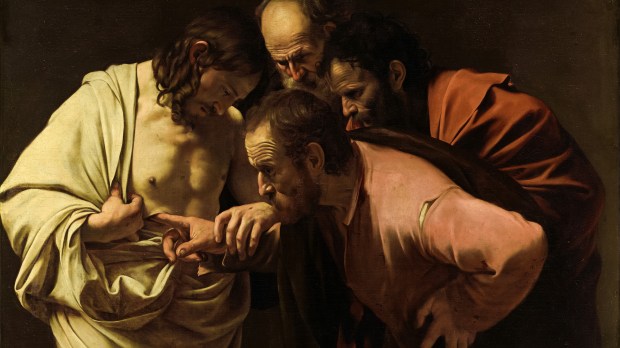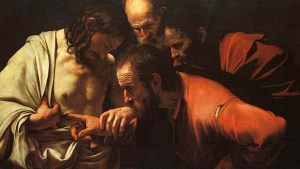Each year on Divine Mercy Sunday — the 2nd Sunday of Easter — the Gospel for Mass is the story of “doubting Thomas” (John 20:19-20, 24-29).
One of Caravaggio’s (+1610) most successful paintings captures this encounter: The Incredulity of Saint Thomas.
But what is the connection between mercy and doubt? The Letter of Jude instructs us: Keep yourselves in the love of God as you await the mercy of our Lord Jesus Christ to bring you eternal life. And have mercy on those who doubt (Jude 1:21-22).
The miracle of mercy
Thomas was the Apostle who, the night before Jesus died, openly lamented, Lord, we do not know where you are going. How can we know the way? (Jn 14:5).
Mercy is the gift of the Lord’s preferential love for us when we deserve it the least. Mercy is the love God imparts simply because God is good — not because we are. Pope St. John Paul II spoke of mercy as the love that “is able to reach down to every human misery. When this happens, the person who is the object of mercy feels found again and restored to value.”
In Caravaggio’s depiction, we have no clue where the scene is taking place. The artist forgoes any sort of setting, and resorts to a bare, dark background. The blackness acts almost as another character: It represents the inky darkness of doubt in which Thomas dwells — his lonely, lightless impenetrability. Impenetrability is keeping our self all closed up, resistant, not letting ourself be touched. Impenetrability is refusing to let ourself be struck by even the most marvelous, beautiful thing that is there right in front of us.
Thank God for something greater than our impenetrability, namely, the Presence of Jesus Christ that never fails to come to us, as Jesus does to Thomas in this painting.
St. John Paul II assures us:
Evil can be overcome if we open ourselves to the love of God to the point of contempt of self. This is the fruit of Divine Mercy. In Jesus Christ, God bends down over man to hold out a hand to him, to raise him up, and to help him continue his journey with renewed strength.
And that is exactly what Caravaggio portrays in his painting. The Risen Jesus is bending down over Thomas, holding out his pierced hand to the Apostle, grasping his wrist and guiding Thomas’ pointed finger — dirty fingernails and all — into his open side. According to the theology of Caravaggio’s painting, there is a way to overcome our impenetrability to divine mercy: by personally penetrating Mercy Incarnate.
The role of doubt in mercy
But is all doubt bad? Not if doubt leads to deeper conviction about Divine Mercy.
Cardinal Joseph Ratzinger made the startling claim that “faith can only mature by suffering anew, at every stage in life, the oppression and the power of unbelief.” Doubt serves to focus and purify us, reordering our priorities. Thomas the Apostle says what he says in the Upper Room, not because he doesn’t want to believe, but precisely because he does want to believe. As Saint Anthony of Padua puts it, “By doubting, Thomas got to know more deeply and to stand more securely.”
After all, belief, as St. Thomas Aquinas understands it, is not principally an inner conviction, and even less a feeling. Belief really involves coming into contact with a truth. And that is what Caravaggio depicts graphically in his painting — Thomas coming into physical contact with Jesus — the Way, the Truth, and the Life.
The painting illustrates how believing is not so much a way of knowing as a way of being known. As Bishop Robert Barron explains:
To have faith is to allow oneself to be overwhelmed by the power of God, to permit the divine energy to reign at all levels of one’s being. God is insisting that knowledge of him comes, not through grasping, but through being grasped.
That is why one of the most compelling details of the painting is not the apostle’s prodding of the wound, but rather that he himself is being grasped by the Risen Savior.
Belief, says Cardinal Ratzinger, “is certainty that God has shown himself and has opened up for us the view of truth itself. The assent of belief comes, not through the degree of evidence bringing the process of thought to its conclusion, but by an act of will — a certain inner closeness, a kind of love.” That inner closeness is represented in the diamond formed by the four heads clustered at the center of the painting. The older apostle, Peter, and the younger man, the Apostle John, together are caught up in the inner closeness that moves them together in love to view the Truth that has been opened up to the world through the opening in Christ’s side.
Which means we must not waste our doubt when we experience it. The poet Rainer Maria Rilke offers key counsel in a letter:
Your doubt can become a good quality if you train it. It must become knowing, it must become criticism. Ask it, whenever it wants to spoil something for you, why something is ugly; demand proofs from it, test it, and you will find it perhaps bewildered and embarrassed, perhaps also protesting. But don’t give in; insist on arguments, and act in this way, attentive and persistent, every single time, and the day will come when, instead of being a destroyer, it will become one of your best workers — perhaps the most intelligent of all the ones that are building your life.
Why Jesus retains his wounds
It is not a coincidence that Caravaggio paints a rip in the shoulder seam of Thomas’ garment. That slit mirrors the one in Jesus’ side, and may symbolize the woundedness of Thomas’ own life.
As painful and degrading as the wounds in our life are, they serve a humanizing and sanctifying purpose. St. Jerome states with great practicality that “if the sick person is too ashamed to show their wound to the doctor, the medicine cannot heal what it does not know.” In an ancient homily read by the Church each Holy Saturday, we hear the Risen Jesus proclaim, “My side has healed the pain in yours.”
Christ’s wounds woo us. The Catechism of the Catholic Church teaches that “the human heart is converted by looking upon him whom our sins have pierced” (CCC 1432). In the painting, Caravaggio deliberately downplays typical traits of Christ’s divine nature: the face of Jesus, the Light of the World, is cast in shadow; the risen Son of God bears no halo. All focus is on his pierced flesh. This is to give the viewer the courage to place their own woundedness into the Redeemer’s wounds. As the Apostle Peter looks on, he witnesses what will come to be expressed in his epistle: By Christ’s wounds you were healed (1 Pt 2:24).
Even more, Christ’s majestic gesture in this event is an invitation, which St. Catherine of Siena describes:
Place yourself in the side of Christ crucified. There make a sweet dwelling place in order to have a holy knowledge of yourself, and a true knowledge of the greatness of God’s goodness.
St. Bernard helps us grasp why this makes great sense:
Where can the weak find a place of firm security and peace except in the wounds of the Savior? Indeed, the more secure is my place there, the more he can do to help me. The world rages, the flesh is heavy, and the devil lays his snares, but I do not fall. I may have sinned gravely. My conscience would be distressed, but it would not be in turmoil, for I would recall the wounds of the Lord. He was wounded for our iniquities. And so if I bear in mind this strong effective remedy, I can never again be terrified by the malignancy of sin.
The supreme irony of it all is that at Mass, when the Host and chalice are elevated at the Consecration, it is the words of the impenetrable, doubting, wounded Apostle Thomas that we invoke in order to express our wholehearted belief in what is held up before us: My Lord and my God.
~
Find Fr. Peter John Cameron’s reflection on the Sunday Gospel each week here.


